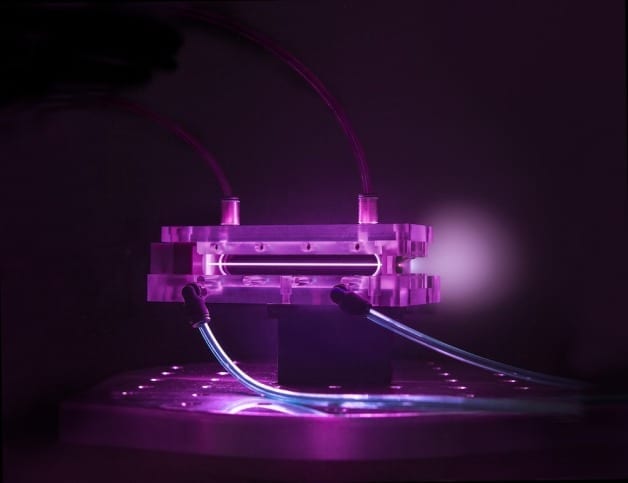
Researchers at Berkeley Lab ramp up energy of laser-plasma “tabletop” accelerator.
Using one of the most powerful lasers in the world, researchers have accelerated subatomic particles to the highest energies ever recorded from a compact accelerator.
The team, from the U.S. Department of Energy’s Lawrence Berkeley National Lab (Berkeley Lab), used a specialized petawatt laser and a charged-particle gas called plasma to get the particles up to speed. The setup is known as a laser-plasma accelerator, an emerging class of particle accelerators that physicists believe can shrink traditional, miles-long accelerators to machines that can fit on a table.
The researchers sped up the particles—electrons in this case—inside a nine-centimeter long tube of plasma. The speed corresponded to an energy of 4.25 giga-electron volts. The acceleration over such a short distance corresponds to an energy gradient 1000 times greater than traditional particle accelerators and marks a world record energy for laser-plasma accelerators.
“This result requires exquisite control over the laser and the plasma,” says Dr. Wim Leemans, director of the Accelerator Technology and Applied Physics Division at Berkeley Lab and lead author on the paper. The results appear in the most recent issue of Physical Review Letters.
Traditional particle accelerators, like the Large Hadron Collider at CERN, which is 17 miles in circumference, speed up particles by modulating electric fields inside a metal cavity. It’s a technique that has a limit of about 100 mega-electron volts per meter before the metal breaks down.
Laser-plasma accelerators take a completely different approach. In the case of this experiment, a pulse of laser light is injected into a short and thin straw-like tube that contains plasma. The laser creates a channel through the plasma as well as waves that trap free electrons and accelerate them to high energies. It’s similar to the way that a surfer gains speed when skimming down the face of a wave.
The record-breaking energies were achieved with the help of BELLA (Berkeley Lab Laser Accelerator), one of the most powerful lasers in the world. BELLA, which produces a quadrillion watts of power (a petawatt), began operation just last year.
The Latest on: Compact particle accelerator
[google_news title=”” keyword=”Compact particle accelerator” num_posts=”10″ blurb_length=”0″ show_thumb=”left”]
via Google News
The Latest on: Compact particle accelerator
- The Best Compact Mechanical Keyboardson May 3, 2024 at 2:17 am
Mechanical keyboards allow you to customize their looks and get the typing feel you prefer. And compact keyboards—which are similar in size and layout to a laptop keyboard—take up less space ...
- Virginia lab wins federal grant to break down forever chemicalson April 29, 2024 at 1:33 pm
The EPA now requires water treatment plants to test for a group of contaminants known as "forever chemicals." Used in products like non-stick coatings and rain wear, these substances are water, grease ...
- Principles and applications of compact laser–plasma acceleratorson April 23, 2024 at 5:00 pm
Based on radiation from moving charges, the most compact and promising schemes rely on the wiggling of relativistic electrons produced in laser–plasma accelerators, either within the plasma ...
- Smoother surfaces make for better acceleratorson April 17, 2024 at 5:00 pm
This orientation map of a nitrogen-doped sample of niobium shows the formation of niobium nitrides (rainbow-colored shards) within grains and along grain boundaries (the grain boundaries shown are ...
- Symmetry’s guide to AI in particle physics and astrophysicson April 16, 2024 at 5:01 pm
We looked at the many forms AI has taken; the ways the technology has helped shape the science (and vice versa); and the ways scientists use AI to advance experimental and theoretical physics, to ...
- Uncover everything we know about the nature of matteron April 13, 2024 at 2:59 am
It’s via evidence from particle accelerators such at the LHC and its predecessors that we derived our best understanding of the nature of matter: the Standard Model of particle physics.
- The Secret to the Strongest Force in the Universeon April 13, 2024 at 1:41 am
In the late 1990s Deur was a Ph.D. student taking data at the Thomas Jefferson National Accelerator Facility (Jefferson Lab) in Virginia, which houses a particle accelerator. His measurements ...
- Higgs boson: The 'God Particle' explainedon April 10, 2024 at 12:04 pm
The particle was detected by both the LHC ATLAS detector and the Compact Muon Solenoid (CMS ... of the LHC and particularly when the particle accelerator's high luminosity upgrade is completed ...
- Dielectric laser accelerator creates focused electron beamon April 9, 2024 at 5:00 pm
Indeed, this is the main reason why accelerators keep getting bigger and more expensive in order to achieve higher particle energies. To create more compact devices, researchers worldwide are ...
- Is CERN activating the world’s most powerful particle accelerator for the April 8 eclipse? Noon April 7, 2024 at 5:00 pm
CERN houses the Large Hadron Collider, the most powerful particle accelerator in the world, which measures around 16.8 miles (27 kilometers) in circumference. The collider’s aim, as Britannica ...
via Bing News









